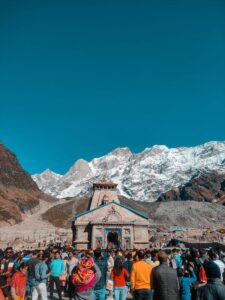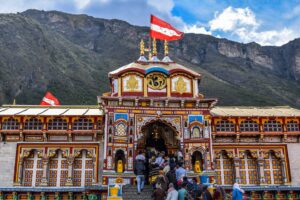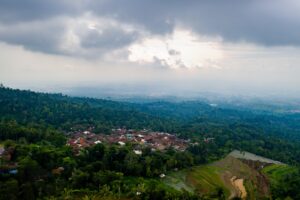Char Dham Yatra
“Char Dham Yatra: A Divine Journey Through the Himalayas”
Char Dham Yatra, often referred to as the ‘Journey to the Four Abodes of God,’ is a sacred pilgrimage in the Indian state of Uttarakhand. It encompasses a spiritual odyssey to four sacred shrines nestled in the majestic Himalayan mountains: Yamunotri, Gangotri, Kedarnath, and Badrinath. These sacred destinations hold immense religious significance for Hindus and are believed to be the dwelling places of various deities. The Char Dham Yatra is an arduous but spiritually rewarding expedition that attracts millions of devotees from across the globe.
Yamunotri
Pilgrims embark on a journey that involves trekking through rugged terrains and crossing the pristine Yamuna River to reach the shrine. The hot water springs of Surya Kund and the Divya Shila are also significant attractions in this region. The spiritual essence of Yamunotri captivates the hearts of pilgrims who believe that a dip in the sacred Yamuna River washes away their sins.
Yamunotri is a sacred town in the Indian state of Uttarakhand, nestled in the Garhwal Himalayas. It is one of the four Char Dham pilgrimage sites for Hindus, along with Gangotri, Kedarnath, and Badrinath. Located at an altitude of approximately 3,293 meters (10,804 feet) above sea level, Yamunotri is known for its spiritual significance and stunning natural beauty.
The chief attraction in Yamunotri is the Yamunotri Temple, dedicated to Goddess Yamuna. This ancient temple, constructed by Maharaja Pratap Shah of Tehri Garhwal, stands as a testament to traditional Indian architecture and religious devotion. Pilgrims and tourists can visit the temple during the summer months, typically from May to October.
Reaching Yamunotri requires embarking on a trek of approximately 6 kilometers from Janki Chatti, the nearest accessible point. The trek takes visitors through picturesque landscapes, dense forests, and across the Yamuna River. The journey itself is an integral part of the spiritual experience, as it immerses travelers in the natural beauty of the region.
Yamunotri is not just a pilgrimage site but also a haven for nature enthusiasts and trekkers. The region offers opportunities for trekking and camping, with several nearby attractions like Surya Kund, a natural hot water spring, and the Kharsali village, known for its ancient architecture and traditions.
The combination of spiritual significance and breathtaking natural surroundings makes Yamunotri a destination that resonates with both religious devotees and lovers of the Himalayan landscape. It’s a place where the devotion to the Goddess Yamuna and the allure of the mountains converge, leaving an indelible impression on all who visit.
Gangotri
The temple is surrounded by the rugged terrain of the Garhwal Himalayas and is one of the most sacred destinations for Hindus. Pilgrims believe that a dip in the icy waters of the Ganges at Gangotri absolves them of their sins. The trek to Gangotri offers awe-inspiring views of the Bhagirathi River, which later becomes the Ganges. The pilgrimage is not only a religious journey but also an opportunity to connect with the pristine natural beauty of the region.
The town of Gangotri is located at an altitude of approximately 3,100 meters (10,200 feet) above sea level, making it one of the highest and most remote pilgrimage destinations in India. To reach Gangotri, one must embark on a challenging journey through winding mountain roads, passing through dense forests and picturesque villages. The beauty of the journey is as mesmerizing as the destination itself, with breathtaking views of snow-capped peaks and pristine landscapes.
The Gangotri temple, dedicated to the Goddess Ganga, is the focal point of this sacred town. It was constructed in the 18th century by Gorkha General Amar Singh Thapa and stands as a symbol of architectural excellence in the region. The temple opens its doors to pilgrims and devotees for a few months each year, typically from May to October, when the harsh winter conditions subside.
Apart from its spiritual significance, Gangotri also offers a captivating natural landscape. The surrounding region is known for its lush green meadows, dense forests, and towering peaks. Trekkers and adventure enthusiasts flock to Gangotri for its numerous trekking and mountaineering opportunities. The Gangotri Glacier, which feeds the Bhagirathi River and eventually becomes the Ganges, is one of the largest glaciers in the Himalayas and a popular trekking destination.
Visitors to Gangotri can explore the serene beauty of the region, go on treks to places like Gaumukh, the snout of the Gangotri Glacier, and Tapovan, or simply enjoy the tranquility and fresh mountain air. However, it’s essential to be prepared for the high-altitude conditions and the unpredictable weather.
Kedarnath
The next stop on the Char Dham Yatra is Kedarnath, dedicated to Lord Shiva. It is one of the twelve Jyotirlingas and is located at an altitude of 3,583 meters in the Rudraprayag district of Uttarakhand. Kedarnath is revered as the place where Lord Shiva is believed to have resided after the Kurukshetra war.
Kedarnath is a sacred town nestled in the Garhwal region of the Indian state of Uttarakhand. It holds immense religious significance for Hindus as one of the Char Dham pilgrimage sites, along with Badrinath, Gangotri, and Yamunotri. Kedarnath is situated in the Kedarnath Wildlife Sanctuary, surrounded by the breathtaking beauty of the Himalayas.
The primary attraction in Kedarnath is the Kedarnath Temple, dedicated to Lord Shiva. This ancient temple is believed to have been constructed over a thousand years ago by Adi Shankaracharya and stands as a remarkable example of medieval architecture. The temple opens its doors to devotees for a limited period each year, usually from April to November, due to the extreme weather conditions in the region.

The journey to Kedarnath is an adventure in itself, as it involves a steep trek of around 14 kilometers from Gaurikund, the nearest accessible point. Pilgrims and tourists walk through scenic landscapes, crossing the Mandakini River, lush forests, and picturesque valleys. Mules and palanquins are also available for those who prefer not to trek on foot.
The town’s spiritual aura and the stunning natural surroundings make Kedarnath not only a place of worship but also a haven for trekkers and nature enthusiasts. The Kedarnath region offers numerous trekking opportunities, including the Vasuki Tal trek and the trek to Chorabari Tal (Gandhi Sarovar), a glacial lake.
Despite the challenges posed by its high-altitude location, Kedarnath remains a popular pilgrimage destination, drawing visitors from all over India and beyond. It is a place where spirituality and the grandeur of the Himalayas converge, leaving a lasting impression on those who make the arduous but rewarding journey to this sacred abode of Lord Shiva.
The temple is located in the Chamoli district of Uttarakhand and is surrounded by the majestic Nar and Narayan mountain ranges. Pilgrims believe that a visit to Badrinath and a dip in the Tapt Kund (hot water spring) purifies their souls. The temple, with its iconic idol of Lord Badrinarayan, is a masterpiece of architecture and a symbol of devotion. The tranquil surroundings and the spiritual ambiance make Badrinath a place of deep reverence.
Badrinath is a revered town located in the Chamoli district of the Indian state of Uttarakhand. It holds immense significance for Hindus as one of the Char Dham pilgrimage sites, along with Kedarnath, Gangotri, and Yamunotri. Nestled in the Garhwal region of the Himalayas, Badrinath is perched at an altitude of approximately 3,133 meters (10,279 feet) above sea level.

The primary attraction in Badrinath is the Badrinath Temple, dedicated to Lord Vishnu in his form as Lord Badrinarayan. This ancient temple, with its distinct architecture and intricate carvings, is an important pilgrimage site for Hindus. The temple is open to devotees during the summer months, typically from May to October, as the region experiences harsh winters.
The journey to Badrinath is an awe-inspiring experience, as pilgrims and tourists traverse steep mountain roads, lush green valleys, and the Alaknanda River. The town is Char Dham Yatra surrounded by towering snow-capped peaks, creating a stunning natural backdrop.
Visitors to Badrinath can explore the spiritual ambiance of the town, participate in the daily rituals at the temple, and take a dip in the Tapt Kund, a natural hot water spring believed to have medicinal properties. The region also offers trekking opportunities, and nearby attractions like Mana Village, the last Indian village on the Indo-Tibetan border, and Vasudhara Falls, a scenic waterfall.
Badrinath remains a place where spirituality and natural beauty harmoniously coexist, making it a significant pilgrimage destination and a sanctuary for nature enthusiasts in the lap of the Himalayas.
“Char Dham Yatra: Gateway to Spiritual Enlightenment“
The Char Dham Yatra is a sacred pilgrimage journey in India that holds profound significance for millions of devotees seeking spiritual enlightenment. Comprising four sacred destinations nestled in the Himalayan region, the Char Dham Yatra offers a transformative experience that connects pilgrims with their inner selves and the divine.
The Char Dham Yatra, a sacred pilgrimage in the Indian Himalayas, holds a special place in the hearts of millions of devotees. This spiritual journey takes travelers through four revered Hindu shrines located in the high altitudes of Uttarakhand state: Yamunotri, Gangotri, Kedarnath, and Badrinath.

The four destinations included in this spiritual journey Char Dham Yatra are Yamunotri, Gangotri, Kedarnath, and Badrinath. Each Char Dham Yatra of these locations is associated with Hindu mythology and is believed to be the abode of various deities. The Yatra begins with a visit to Yamunotri, where the Yamuna River, considered the sister of Lord Krishna, originates. Char Dham Yatra Pilgrims take a dip in the sacred Yamuna and offer prayers for purification.
Next, the journey Char Dham Yatra continues to Gangotri, the source of the holy Ganges River. It is believed that taking a dip in the Ganges at this spot cleanses one of their sins and paves the way for spiritual awakening.
Kedarnath, the third destination, is where Lord Shiva is worshipped as the ‘Lord of Kedar.’ Pilgrims trek to the Kedarnath Temple, set amidst stunning Himalayan landscapes, and meditate in its serene ambiance.
Finally, the Char Dham Yatra culminates in Badrinath, where Lord Vishnu is revered. The Badrinath Temple is a symbol of peace and spirituality, offering a profound sense of connection with the divine.
The Char Dham Yatra not only provides a chance for devotees to pay their respects to these sacred deities but also offers an opportunity for self-discovery and spiritual growth. The strenuous journey through the Himalayas, combined with the serene and pristine surroundings, encourages introspection and a deep connection with nature and the divine.
Char Dham Yatra: Seeking Blessings in the Himalayas
Char Dham Yatra is not just a physical journey; it is a profound spiritual experience. Devotees believe that embarking on this pilgrimage and seeking blessings at these shrines will cleanse their souls and pave the way for spiritual growth and enlightenment. The challenging terrains, serene landscapes, and the Himalayan backdrop add to the mystical aura of this yatra.
Pilgrims from all over India and the world undertake this arduous journey, often enduring extreme weather conditions and physical challenges. The pilgrimage typically takes place during the summer months when the shrines are accessible. However, the journey can be demanding due to high altitudes and unpredictable weather. It requires careful planning and preparation to ensure a safe and meaningful experience.
The yatra is also an opportunity to connect with fellow travelers and share in the collective spirit of devotion. Pilgrims often bond over their shared experiences and challenges, forging new friendships and creating a sense of unity that transcends societal boundaries. The sense of camaraderie on the journey is a testament to the unifying power of faith.

Char Dham Yatra While the spiritual aspect of Char Dham Yatra is paramount, it also has a significant impact on the local economy. The pilgrimage season brings a surge of tourists, creating employment opportunities for the local population. The region’s economy relies heavily on the influx of pilgrims, as it sustains hotels, restaurants, and various other businesses.
Char Dham Yatra is not just a religious journey; it is a testament to the enduring faith and spirituality of the people who undertake it. It offers an opportunity to connect with the divine in the lap of the majestic Himalayas, making it a cherished and unforgettable experience for all who seek blessings in this sacred land.
